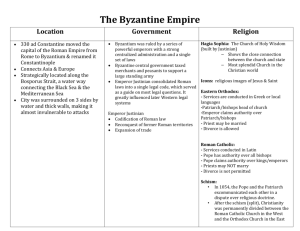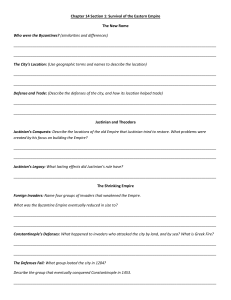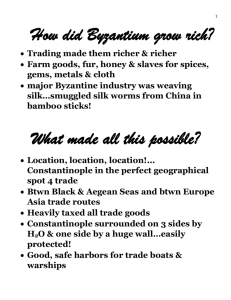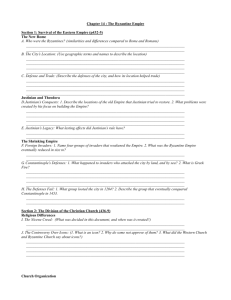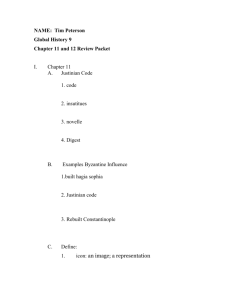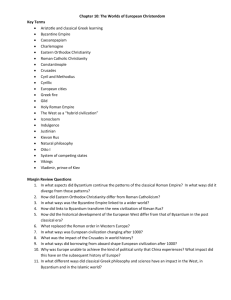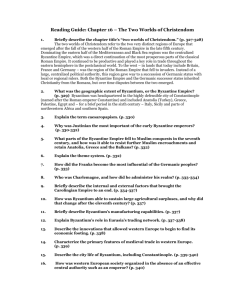Byzantium
advertisement
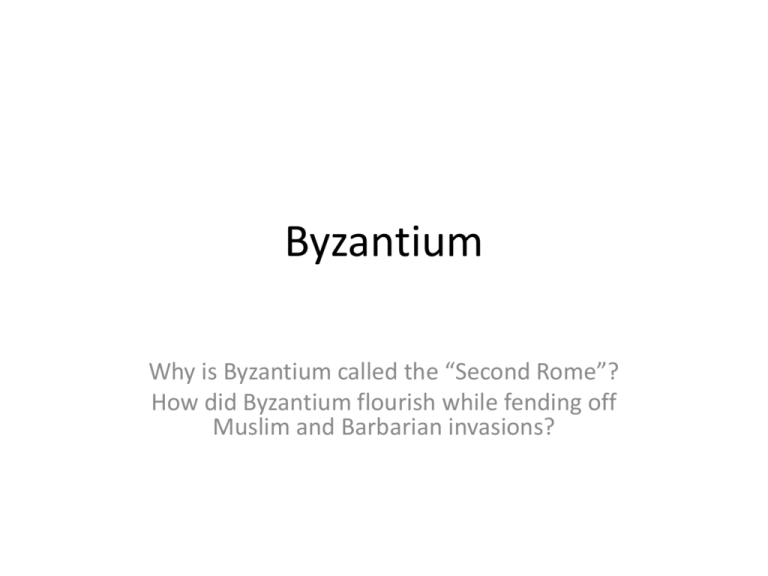
Byzantium Why is Byzantium called the “Second Rome”? How did Byzantium flourish while fending off Muslim and Barbarian invasions? Beginnings • It was Constantine the Great who began the re-building of Byzantium in 324, naming the city Constantinople and dedicating it in 330. This founding marks the early beginnings of the empire. • Constantinople became the sole capital of the Eastern Roman Empire • The death of the complete Roman Empire in 476 AD marked the birth of the new Roman Empire in Constantinople. Greek influences resurfaced. • Greek thus became primary language in the 6th C • The empire was renamed Byzantine after the city Byzantium which was renamed Constantinople. • The empire benefited from being the focal point of trade from east to west and vice versa Justinian • The greatest of all the eastern emperors was clearly Justinian (c.482-565), who reigned for thirty-eight years between 527 and 565. • Justinian was a reformer in the fashion of Augustus Caesar. • It was Justinian's desire to restore the Empire -- both East and West -- to all of its former glory. • In fact, it has been said that his desire to restore the former Roman Empire was an obsession (Nova Roma) Justinian • His greatest accomplishment toward this end was the revision and codification of Roman law. Justinian understood that a strong government could not exist without good laws. • The Byzantine laws had grown too numerous and too confusing. • Justinian created a commission of sixteen men to bring order out of all the laws. • These men worked for six years and studied more than 2000 texts. • In 534, the commission produced the Corpus Juris Civilis – the Body of Civil Law (Justinian Code). – Contained laws pertaining to religion, anti-paganism, heresy crimes and anti-Semitism Theodora’s Influence • • • • • • Justinian was aided by his wife, Theodora (c.500-547), the daughter of a bearkeeper at the Hippodrome, and was no less ambitious than her husband. In 532, mob violence erupted in Constantinople. These riots were called the Nika Riots ("Nika"= "Victory!"), and grew from political unrest over the government's fiscal measures. Rival factions of Blues and Greens (admirers of rival chariot-racing teams) fought in the streets over the results of a chariot race (kinda like soccer hooligans). Some Byzantine Senators saw this riot as an opportunity to overthrow Justinian Justinian wanted to leave the city during the riots, but two of his generals (Belisarius and Narses) and his wife Theodora, persuaded him to stay. Theodora took it upon herself to raise a personal army, an army that eventually killed 35,000 people in a single day and expelled the plotting senators. Arab Pressures • Justinian’s successors began to concentrate on protecting the eastern frontier from Muslim invasions • The Byzantine Empire managed to withstand this threat, but not without losses • Byzantine control over the Mediterranean realm began to slip as the Arabs built a strong navy • Byzantium also held off a siege of Arab ships by using a new weapon called “Greek fire” • The empire lost key points in Phoenicia, Palestine and Egypt The Bulgars • The most serious challenge to Byzantium was Bulgaria • Bulgarian kings were feisty and resisted Byzantine rule from Constantinople’s founding all the way thru the 11th century • 1014 – Basil II finally defeated the Bulgarian threat; he blinded their captive soldiers and bribed as many of their generals to gain their favor Society/Politics • Similar to early China – Emperor ordained by God, was head of Orthodox church • Women held considerable authority throughout the empire’s history – Theodora (NOT Justianian’s wife) exerted her power as emperor • An elaborate bureaucracy (China similarity again) supported the emperor, one educated in Greek traditions/knowledge – Members of this bureaucracy could come from any social classes, though aristocrats dominated – This bureaucracy regulated trade (Silk Road) and food prices as well as taxed the peasants for resources • Military organization similar to Roman organization – Peasants served the army in return for land grants that could be passed down via inheritance Society/Politics • • • Empire depended on control over countryside (rural base) – A large controlled peasant class was crucial to providing tax revenue to the empire’s treasury – The empire was not very urbanized; Constantinople was only large city Trade was crucial – Held together the network of trade that linked China/India to the newly emerging European kingdoms Life was centered on secular Greek traditions – Orthodox Christian artwork was took mosaic form, which even brought controversy (icons were considered graven idols) Religious Influence and Issues • • • • • Little innovative artistic creativity emerged from Byzantium save those in the forms of religious arts and architecture (still influenced by Rome and Greece) The construction of domed churches (ie. Haggia Sophia) continued Roman architectural forms The creation of mosaics and icon painting flourished, enough to cause controversy…a brief clash over iconoclasm ensued (concern that icons were idols)…eventually it disappeared What did occur was a rift between the West (Rome and Catholicism) and the East (the Orthodox Church of Byzantium)…the Greek Bible was translated into Latin…popes got involved with the iconoclasm issue…Charlemagne becomes declared the “true heir of Rome” In 1054, the schism was made official (thanks to an argument over bread and sex) as pope and head of the Orthodox church excommunicated each other Spreading Byzantium • Emperors realized they could gain influence over other areas by spreading Orthodox faith in Slavic “Cyrillic” language translation to various “barbaric” societies • Missionaries like St. Cyril and Methodius went into Eastern Europe and Kievan Russia and brought them a new language and a new faith • Each area was absorbed into the Byzantine Empire through this conversion
